

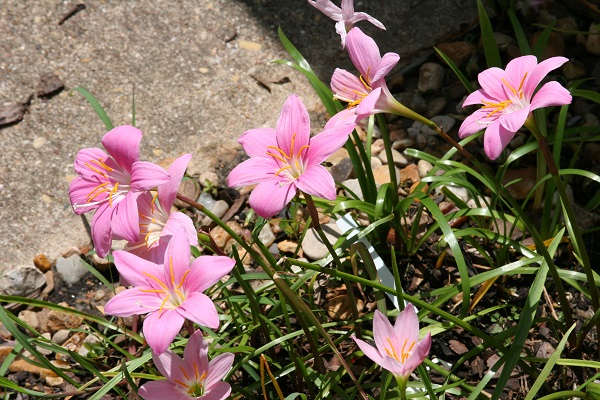
There are many rain lilies that bloom all across the world, but few put on the show of Zephyranthes grandiflora. This is the large flowered traditional pink rain lily. The joyful flowers open wide on stalks about 3-6 inches above their flattened dark green foliage. They bloom through the hottest part of summer and will bloom numerous times, usually following a rain. Summer thundershowers, with their splash of water and quick cooling of temperatures, trigger massive blooms three to five days after the storm has passed. This is why they are called rain lilies!
One of my earliest bulb hunting experiences was with LSU horticulture professor Dr. Neil Odenwald. He took me to an abandoned lot and we discovered Crinum jagus and a pink rain lily clumping up in beautiful clusters of pink in this seemingly abandoned garden. It was the Zephyranthes grandiflora. The rich pink flowers open up into star shaped blooms and begin to grace June gardens this time of year.
Perhaps my favorite landscape use of these pink rain lilies is to see them mixed in with liriope, a common ornamental grass border. The casual eye rarely notices the difference in foliage between the rain lilies and the liriope, but 3-5 days after a good rain in June and July, that "common" border explodes in large popcorns of star shaped pink blooms. As my former horticulture advisor at Texas A&M told me, "I love rain lilies because they are like old friends that pop back into your life. You haven't seen them in ages but you are so glad to see them again." Thank you Sharon, for such a great quote!
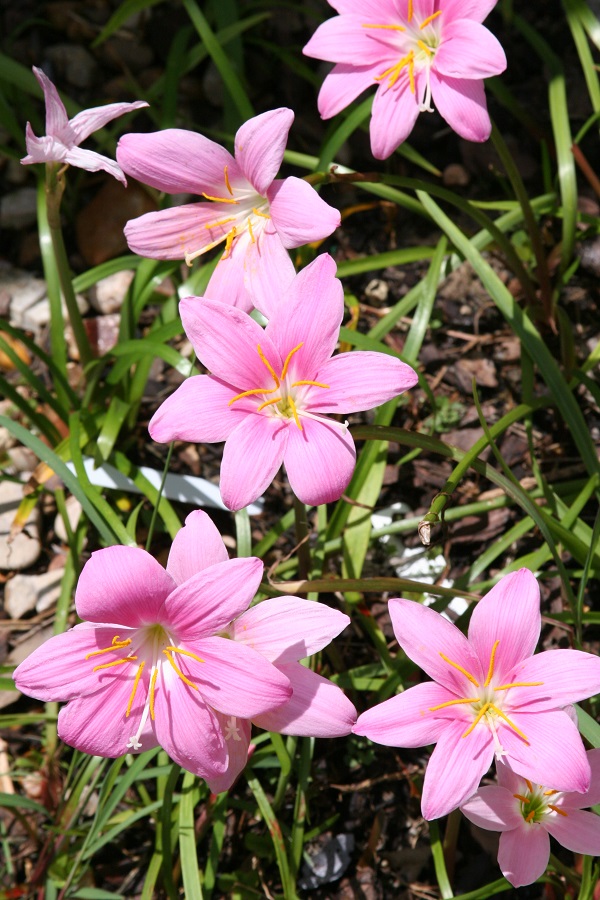
The Zephyranthes grandiflora provides so much color all summer long that it makes us happy every time the flowers bloom. Anyone who lives in zones 8-10 can appreciate any flower that will bloom over and over during the hot summer months. We love that the flowers bloom well when we water them, but they are absolutely amazing when the smallest shower occurs. Just when you are sure that the southern summer heat was too much for them along comes a rain and your area is transformed into a sea of bright pink.
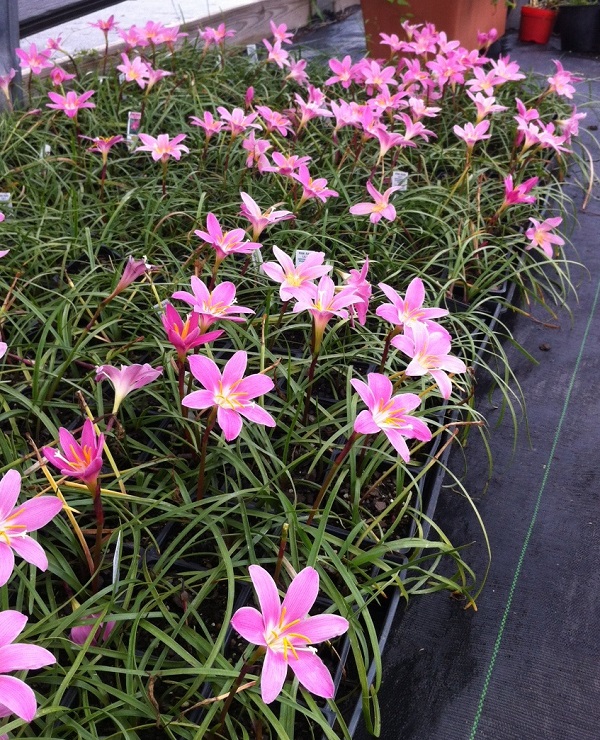
Landscape: This bloom works great in full summer sun, but it can certainly appreciate a few hours of summer shade each day. This bulb works well under irrigation especially if it is a dry summer. The foliage alone is beautiful even when the flowers aren't in bloom. This bulb requires very little maintenance. These larger rain lily bulbs quickly clump and spread, offering a showy display in an otherwise dormant summer garden. The dark pink showy displays make great borders easily seen from afar. These special bulbs are uniquely suited for warm climates and require very little maintenance. Normally, all that is required is some manual weeding around the clumps of bulbs as they grow with other active summer plants and seeds.

Planting: The most asked question that we get is "How close together should I plant the bulbs?" Our answer is "It depends on what you are trying to achieve." In other words, if you want the area to look natural, plant the bulbs about 2 inches apart, but if you are willing for the area to look a little sparse for a couple of years, then plant the bulbs about 4-6 inches apart. These multiply quickly and will fill in but it will take a couple of years. The picture above has about 2 bulbs in each 4 inch pot. Be sure to plant the bulbs no more 2-3 times the height of the bulb (so about 4 inches deep).
These work great planted in pots for everyone but especially for zones colder than 8. Just move them in to a garage or shop during the winter.
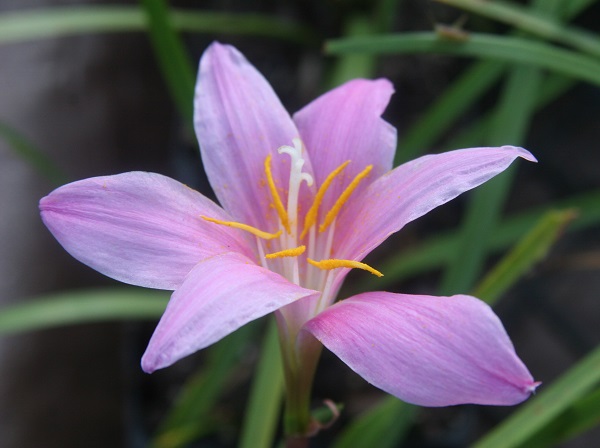
Color: Many often wonder why they should have more than one kind of pink rain lily in their garden. We love having the Habranthus robustus and the Zephyranthes grandiflora together. When comparing the Zephyranthes grandiflora to our other popular rain lily, Habranthus robustus, think about these differences:
1) The Zephyranthes grandiflora blooms with an open, star-like look, while the Habranthus robustus has a more trumpet, elongated bloom.
2) Blooms on a Z. grandiflora are so vibrant they are almost an iridescent combination of pink, purple, and maybe even a hint of blue while the H. robustus are more lighter pink.
3) Foliage on the Z. grandiflora is darker green and smaller, while the H. robustus foliage is a paler and flatter green foliage.
4) The Zephyranthes grandiflora are shorter than the Habranthus robustus and that makes for a great layering in your garden.
5) The H. robustus begin to bloom in April/May, and the Z. grandiflora blooms the first of June and continues during the heat of the summer. Their bloom-time overlaps for several weeks during the end of May and June so you get a stunning combination from flowers with complementary characteristics to help create a harmonious and appealing design.
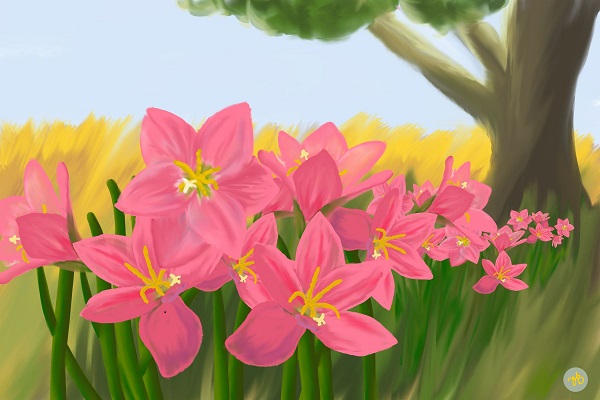
Dependable: The Zephyranthes grandiflora thrives in zones 8-10. It multiplies quickly throughout the hot humid summer months in the south. This is a perennial bulb so it needs time to get established, but we always plant with next year in mind. It can absolutely be planted during the summer because that gives it time to get established. This little bulb will quickly fill your garden with bright blooms and lovely greenery all summer long.
Looking for other rain lilies? Check out our rain lily page here.

There are many rain lilies that bloom all across the world, but few put on the show of Zephyranthes grandiflora. This is the large flowered traditional pink rain lily. The joyful flowers open wide on stalks about 3-6 inches above their flattened dark green foliage. They bloom through the hottest part of summer and will bloom numerous times, usually following a rain. Summer thundershowers, with their splash of water and quick cooling of temperatures, trigger massive blooms three to five days after the storm has passed. This is why they are called rain lilies!
One of my earliest bulb hunting experiences was with LSU horticulture professor Dr. Neil Odenwald. He took me to an abandoned lot and we discovered Crinum jagus and a pink rain lily clumping up in beautiful clusters of pink in this seemingly abandoned garden. It was the Zephyranthes grandiflora. The rich pink flowers open up into star shaped blooms and begin to grace June gardens this time of year.
Perhaps my favorite landscape use of these pink rain lilies is to see them mixed in with liriope, a common ornamental grass border. The casual eye rarely notices the difference in foliage between the rain lilies and the liriope, but 3-5 days after a good rain in June and July, that "common" border explodes in large popcorns of star shaped pink blooms. As my former horticulture advisor at Texas A&M told me, "I love rain lilies because they are like old friends that pop back into your life. You haven't seen them in ages but you are so glad to see them again." Thank you Sharon, for such a great quote!

The Zephyranthes grandiflora provides so much color all summer long that it makes us happy every time the flowers bloom. Anyone who lives in zones 8-10 can appreciate any flower that will bloom over and over during the hot summer months. We love that the flowers bloom well when we water them, but they are absolutely amazing when the smallest shower occurs. Just when you are sure that the southern summer heat was too much for them along comes a rain and your area is transformed into a sea of bright pink.

Landscape: This bloom works great in full summer sun, but it can certainly appreciate a few hours of summer shade each day. This bulb works well under irrigation especially if it is a dry summer. The foliage alone is beautiful even when the flowers aren't in bloom. This bulb requires very little maintenance. These larger rain lily bulbs quickly clump and spread, offering a showy display in an otherwise dormant summer garden. The dark pink showy displays make great borders easily seen from afar. These special bulbs are uniquely suited for warm climates and require very little maintenance. Normally, all that is required is some manual weeding around the clumps of bulbs as they grow with other active summer plants and seeds.

Planting: The most asked question that we get is "How close together should I plant the bulbs?" Our answer is "It depends on what you are trying to achieve." In other words, if you want the area to look natural, plant the bulbs about 2 inches apart, but if you are willing for the area to look a little sparse for a couple of years, then plant the bulbs about 4-6 inches apart. These multiply quickly and will fill in but it will take a couple of years. The picture above has about 2 bulbs in each 4 inch pot. Be sure to plant the bulbs no more 2-3 times the height of the bulb (so about 4 inches deep).
These work great planted in pots for everyone but especially for zones colder than 8. Just move them in to a garage or shop during the winter.

Color: Many often wonder why they should have more than one kind of pink rain lily in their garden. We love having the Habranthus robustus and the Zephyranthes grandiflora together. When comparing the Zephyranthes grandiflora to our other popular rain lily, Habranthus robustus, think about these differences:
1) The Zephyranthes grandiflora blooms with an open, star-like look, while the Habranthus robustus has a more trumpet, elongated bloom.
2) Blooms on a Z. grandiflora are so vibrant they are almost an iridescent combination of pink, purple, and maybe even a hint of blue while the H. robustus are more lighter pink.
3) Foliage on the Z. grandiflora is darker green and smaller, while the H. robustus foliage is a paler and flatter green foliage.
4) The Zephyranthes grandiflora are shorter than the Habranthus robustus and that makes for a great layering in your garden.
5) The H. robustus begin to bloom in April/May, and the Z. grandiflora blooms the first of June and continues during the heat of the summer. Their bloom-time overlaps for several weeks during the end of May and June so you get a stunning combination from flowers with complementary characteristics to help create a harmonious and appealing design.

Dependable: The Zephyranthes grandiflora thrives in zones 8-10. It multiplies quickly throughout the hot humid summer months in the south. This is a perennial bulb so it needs time to get established, but we always plant with next year in mind. It can absolutely be planted during the summer because that gives it time to get established. This little bulb will quickly fill your garden with bright blooms and lovely greenery all summer long.
Looking for other rain lilies? Check out our rain lily page here.